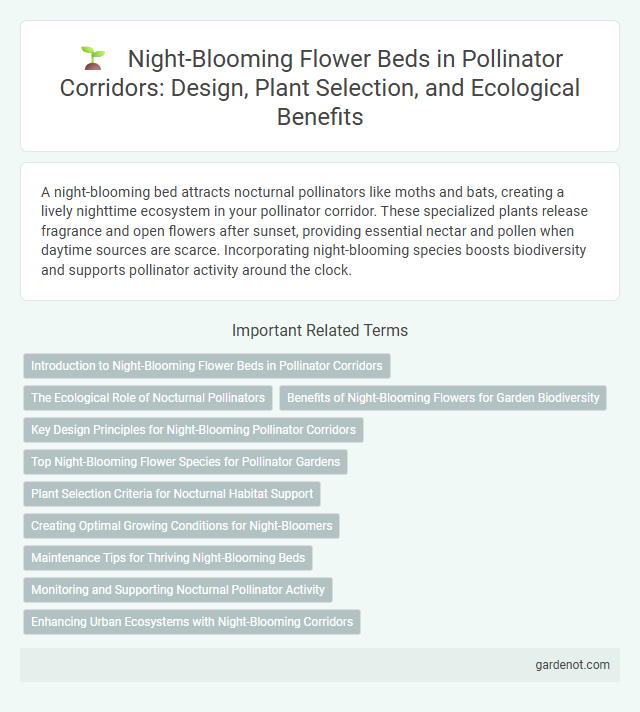A night-blooming bed attracts nocturnal pollinators like moths and bats, creating a lively nighttime ecosystem in your pollinator corridor. These specialized plants release fragrance and open flowers after sunset, providing essential nectar and pollen when daytime sources are scarce. Incorporating night-blooming species boosts biodiversity and supports pollinator activity around the clock.
Introduction to Night-Blooming Flower Beds in Pollinator Corridors
Night-blooming flower beds in pollinator corridors create essential habitats for nocturnal pollinators like moths and bats, enhancing biodiversity and ecosystem health. These beds feature species such as evening primrose, moonflower, and night-blooming jasmine, which release strong fragrances to attract nighttime pollinators. Incorporating night-blooming plants into pollinator corridors supports continuous pollination cycles and improves plant reproductive success throughout the 24-hour period.
The Ecological Role of Nocturnal Pollinators
Night-blooming beds attract nocturnal pollinators such as moths, bats, and certain beetles that play a crucial role in maintaining biodiversity and supporting ecosystem services. These pollinators facilitate the reproduction of night-flowering plants like evening primrose and moonflower, enhancing genetic diversity and habitat resilience. By sustaining plant populations that bloom after dark, nocturnal pollinators contribute to the stability of pollinator corridors and overall ecological balance.
Benefits of Night-Blooming Flowers for Garden Biodiversity
Night-blooming flowers in pollinator corridors enhance garden biodiversity by attracting nocturnal pollinators like moths, bats, and certain beetles, which are essential for plant reproduction and ecosystem health. These plants provide critical nectar and pollen resources during nighttime, expanding the pollination window beyond daylight hours and supporting a wider range of species. Incorporating night-blooming beds helps maintain balanced ecosystems by fostering diverse pollinator populations and promoting genetic diversity among plants.
Key Design Principles for Night-Blooming Pollinator Corridors
Night-blooming bed designs incorporate plants such as moonflowers and evening primroses that attract nocturnal pollinators like moths and bats by emphasizing strong, sweet fragrances and pale, reflective blooms. Strategic placement ensures these corridors connect fragmented habitats, facilitating safe nighttime movement and enhancing pollination efficiency within urban and rural landscapes. Incorporating layers of vegetation with varying bloom times supports continuous nectar availability and sustains diverse nocturnal pollinator populations.
Top Night-Blooming Flower Species for Pollinator Gardens
Night-blooming flower species such as moonflowers (Ipomoea alba), night-blooming jasmine (Cestrum nocturnum), and evening primrose (Oenothera biennis) are essential for pollinator gardens targeting nocturnal pollinators like moths and bats. These plants emit strong fragrances and display bright white or pale blossoms to attract pollinators in low-light conditions. Incorporating these top night-blooming species in a pollinator corridor supports biodiversity by enhancing nighttime foraging opportunities for vital pollinators.
Plant Selection Criteria for Nocturnal Habitat Support
Plant selection for a night-blooming bed in a pollinator corridor prioritizes species with strong nocturnal scent emission and pale or white flowers to attract moths, bats, and other night-active pollinators. Plants such as evening primrose (Oenothera spp.), night-blooming jasmine (Cestrum nocturnum), and moonflower (Ipomoea alba) provide essential nectar sources while thriving in local climate and soil conditions. Ensuring a continuous bloom cycle and avoiding pesticides enhances habitat quality and supports nocturnal pollinator biodiversity.
Creating Optimal Growing Conditions for Night-Bloomers
Night-blooming plants thrive in well-drained soil enriched with organic matter to retain moisture without waterlogging. Providing a shaded area with indirect moonlight exposure supports their nocturnal flowering cycle. Maintaining stable evening temperatures between 60-70degF enhances pollinator activity and optimal growth.
Maintenance Tips for Thriving Night-Blooming Beds
Night-blooming beds require regular pruning to remove spent flowers and promote continuous blooming throughout the season. Consistent watering, especially during dry spells, ensures healthy root development and vibrant blossoms that attract nocturnal pollinators like moths and bats. Mulching around plants helps retain soil moisture, suppress weeds, and maintain temperature stability, optimizing conditions for night-blooming species.
Monitoring and Supporting Nocturnal Pollinator Activity
Night-blooming beds create vital habitats for nocturnal pollinators such as moths, bats, and beetles, supporting biodiversity and ecological balance. Monitoring these beds involves using infrared cameras and acoustic sensors to track pollinator visits and activity patterns during nighttime hours. Data collected informs habitat management practices, ensuring optimal flowering schedules and resource availability to enhance nocturnal pollination efficiency.
Enhancing Urban Ecosystems with Night-Blooming Corridors
Night-blooming beds create vital pollinator corridors that boost urban biodiversity by supporting nocturnal pollinators such as moths and bats. These corridors improve ecosystem resilience and promote nighttime ecological interactions essential for plant reproduction and food webs. Integrating night-blooming plants into city landscapes enhances air quality, soil health, and overall urban environmental sustainability.
Night-blooming bed Infographic

 gardenot.com
gardenot.com